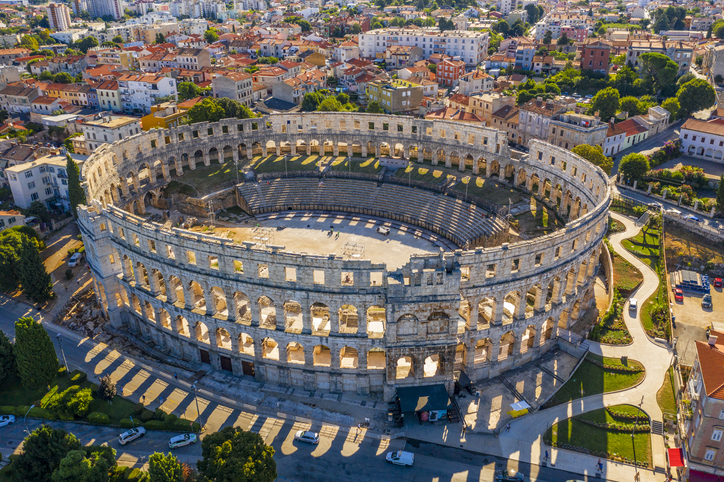
Table of Contents
The vibrant seaport city of Pula, the largest city in Croatia’s Istria region, is a mix of well-preserved Roman ruins, Gothic, Baroque, and Venetian architecture. And (sigh) industry too.
But don’t let a few old naval shipyards and factories stop you from visiting.
You’ve got to see Pula, even if it’s just for a day.
Date of Visit: September 21, 2022
Pula is a cultural tapestry woven by civilizations from Rome and Venice to Austria-Hungary. Reminders of the city’s rich history—ancient Roman monuments, medieval churches, and Austro-Hungarian architecture—are everywhere.
It’s unlikely that your world history teacher ever mentioned Pula, but it is a must-see for anyone interested in European history and culture.

Tracing Pula's Ancient Footsteps
It’s also unlikely Pula was mentioned in your freshman-level anthropology class. It wasn’t in mine, but I was surprised to learn there’s evidence of prehistoric life near Pula too.
The earliest known inhabitants of the surrounding area were Late Upper Paleolithic Homo sapiens sapiens (a subset of Home sapiens), whose remains were found in a cave six miles from Pula. The ancient Greeks, or at least their pottery, followed some time after, as did the Histri tribal peoples, the Romans, and the Southern Slavs.
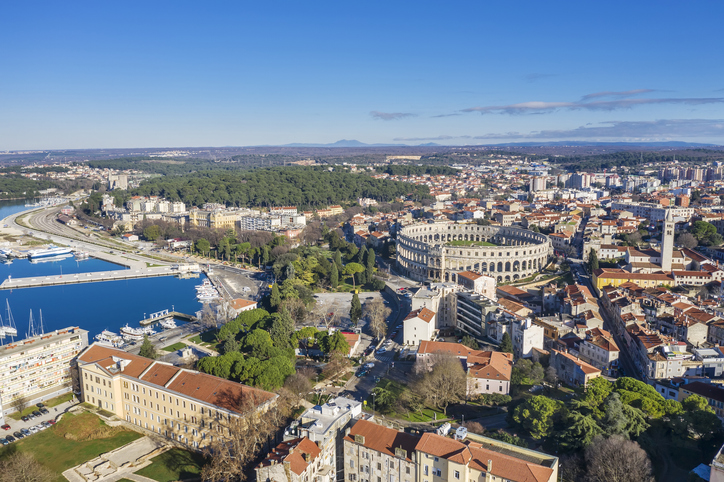
Nonetheless, the first-century Romans left the biggest footprint with the impressive shell of a large amphitheater that today’s residents call the Pula Arena. Other Roman arches, temples, and carved stone gates honoring emperors and gods are scattered in and around the Old Town.
Those are the things you shouldn’t miss.
Tunnels of History
Later generations have left their mark on Pula too.
The Venetians built the hilltop Fortress Kaštel (“castle”) to defend the city and port in the 1600s. Today, The Archeological Museum of Istria inside the Kaštel houses thousands of Istrian historical, cultural, political, and military displays. Its hilltop location also offers a great view and is believed to have been built on the site of a Histri fort (11th BC to 177 BC).
An extensive tunnel system called the Zerostrasse runs underneath Pula and can be accessed at the Kaštel just past the old Roman Twin Gates pictured below.
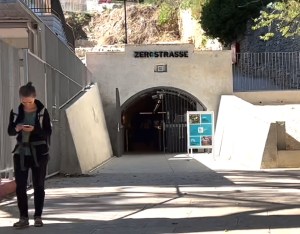
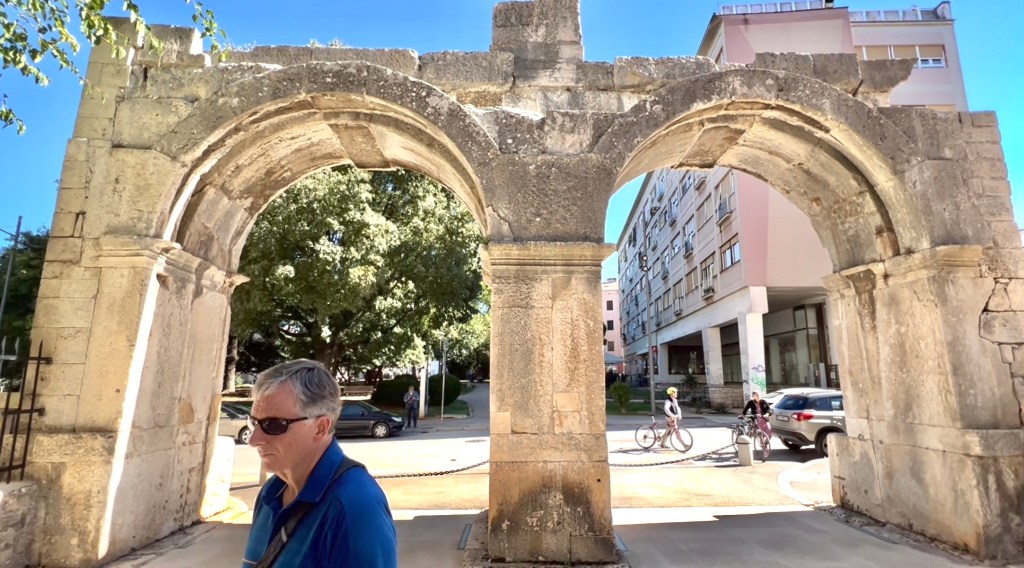
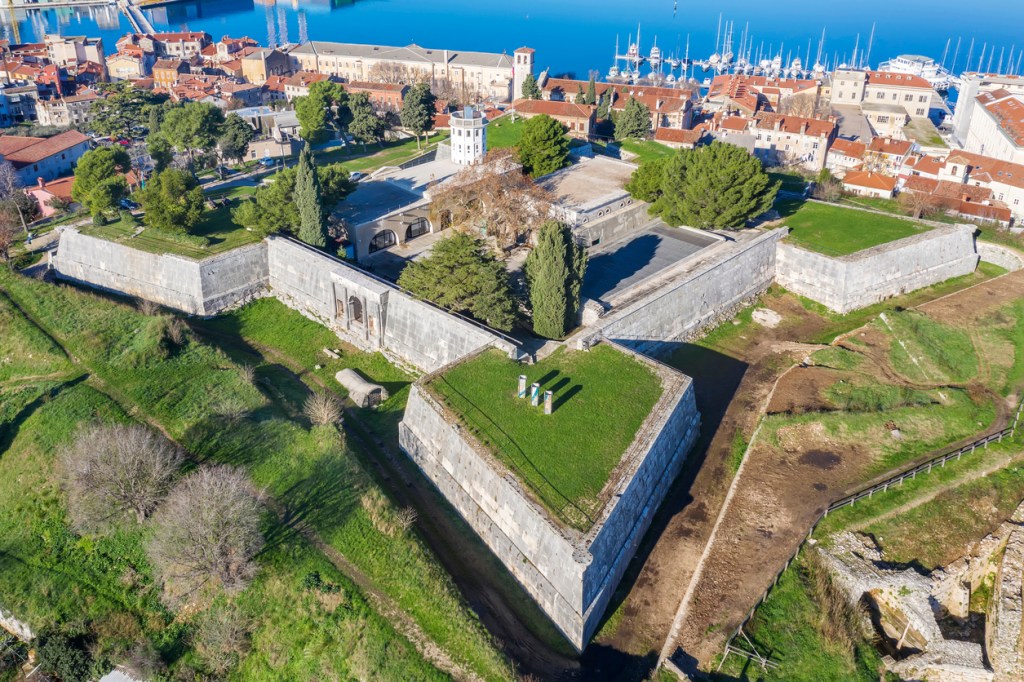
Zerostrasse is Ground Zero
The Austro-Hungarians built underground tunnels during World War I to protect their naval personnel and employees. After the Great War, they expanded the tunnels and used them as air raid shelters and hospitals.
Little is known about their use during World War II when the Nazis collaborated with Italy’s fascist leader Benito Mussolini and occupied Pula. However, it is known that the Anglo-American air forces bombed and destroyed much of the “Old Town” in an attempt to root the fascists and Nazis out.
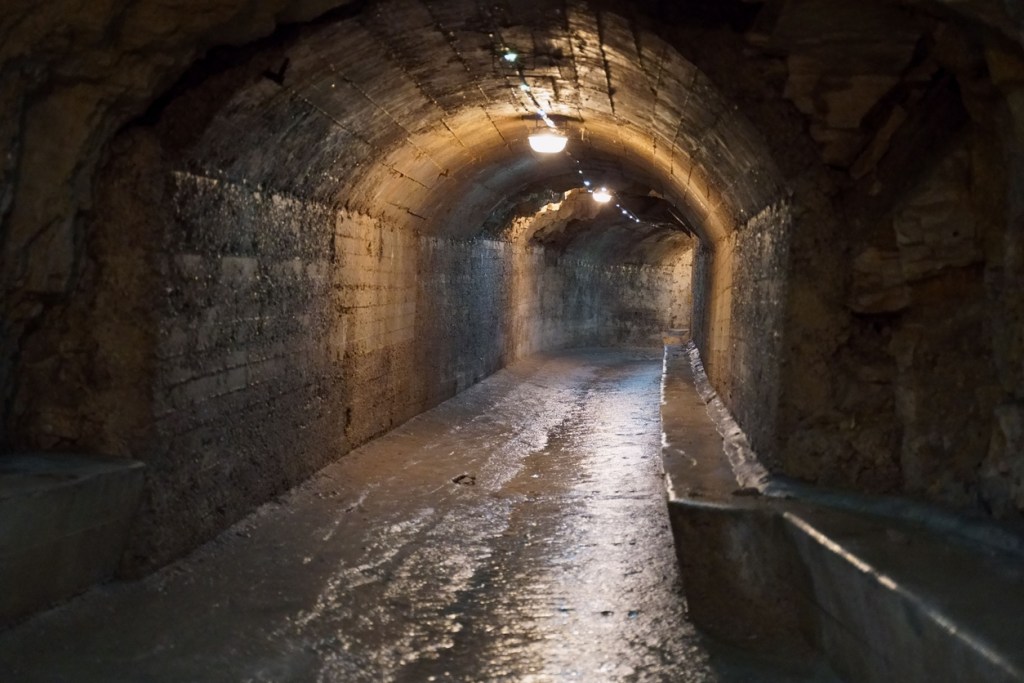
After World War II, the newly-formed country of Yugoslavia, of which Istria and the rest of Croatia were a part, designated the tunnels as a shelter for the residents in case of a biological attack.
It’s estimated that 50,000 people can be sheltered in the underground caves. But let’s do the math. Pula’s population has grown to 52,500, leaving 2,500 out of luck. And let’s not even think about all the tourists.
Click here to jump to a map and list of What To See at the bottom of this post.
Meeting Gwen Stefani Incarnate
Pula was to be a day trip for us. We had arrived in the seaside town of Rovinj the night before, and at 9:00 am that morning, our hired driver picked us up for the 40-minute drive south to Pula.
Martina was waiting as we approached the curb just outside the Pula Arena’s entrance. With her golden blond curls and dark sunglasses, Martina is Gwen Stefani incarnate. She wore a baby blue pleated skirt covered in white polka dots. Decorative suspenders framed a vibrant pink t-shirt.

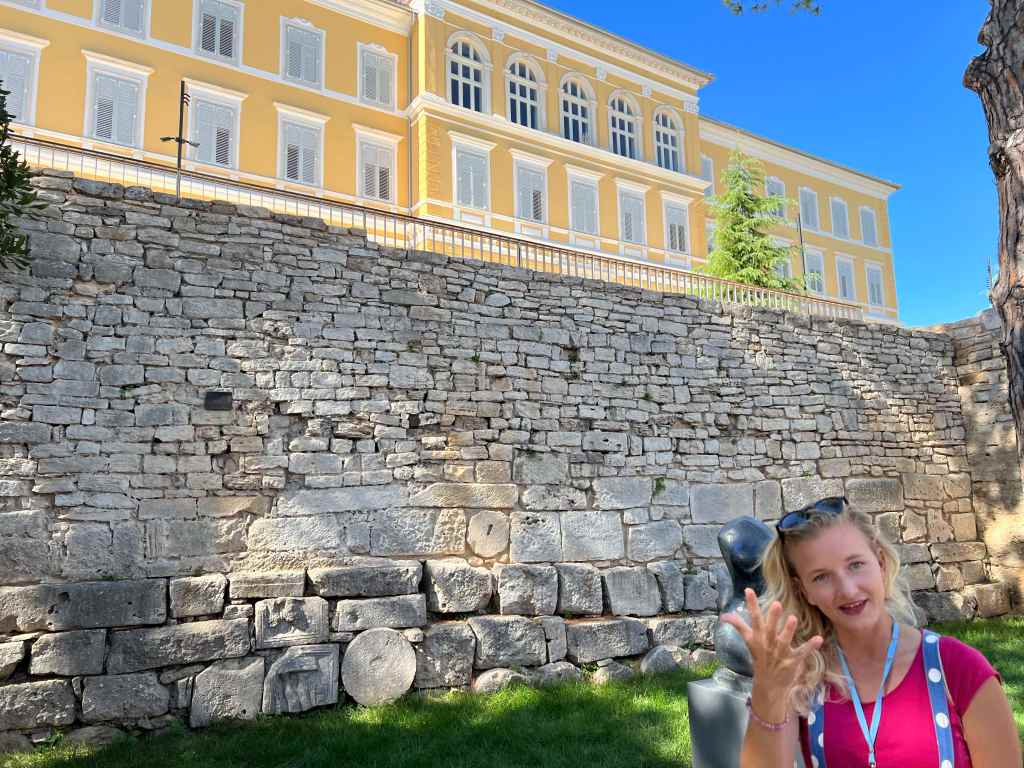
We followed this sneaker-clad force of nature for the next two hours around the old part of town.
Martina was an entertaining mix of city tour guide and grade school teacher. As one would expect from a teacher, which she is, she made our tour an interactive journey through history.
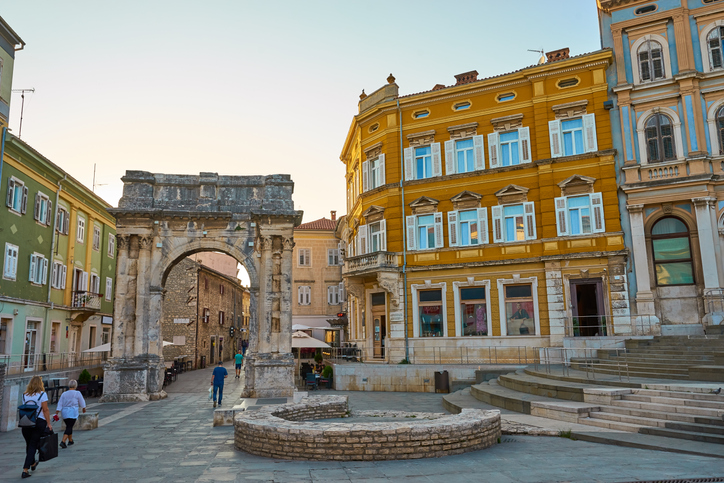
Infectious Pula Tour with Martina
As the bright morning sun began to warm the Pula Arena’s nearly 2,000-year-old stone bleachers, Martina sat us down and gave us a spirited lecture. She painted a vivid picture of the gladiator battles that entertained 20,000 spectators in the Pula Arena after its completion in 68 AD.
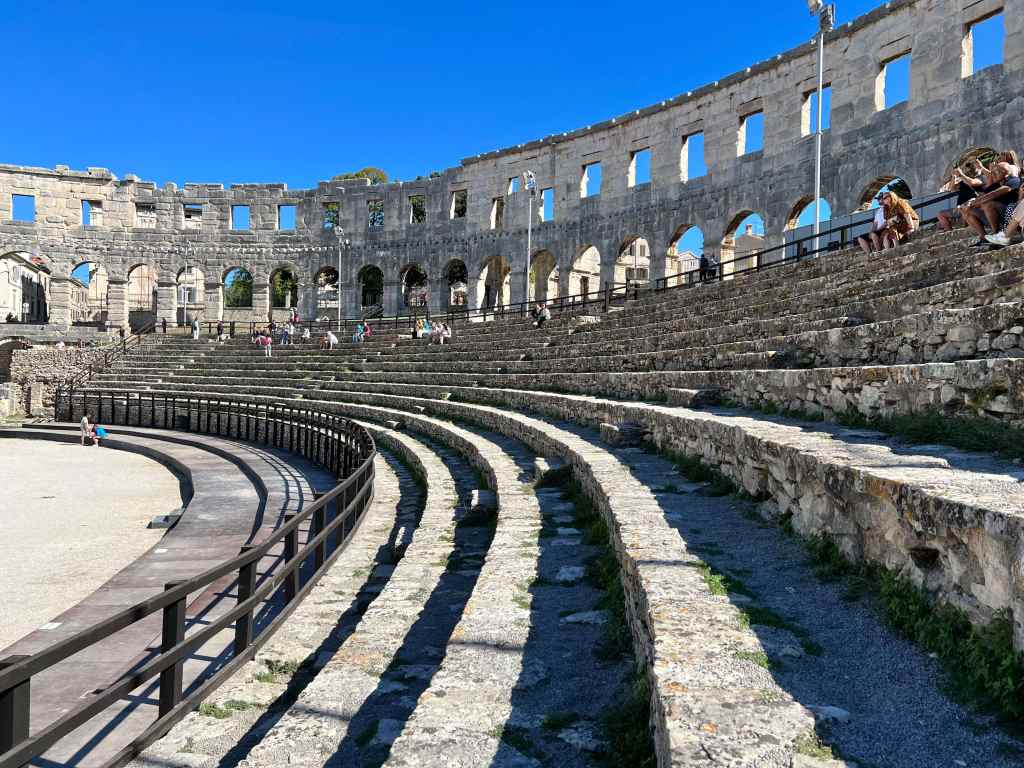
The Pula Arena
Workers toiled for 41 years to build the arena, whose bleachers now sprout weeds. The Pula Arena was completed a few years before the much larger Colosseum in Rome, which could seat 50,000 people. Before our trip to Croatia, I had never heard of Pula or its arena. I was completely surprised by how much Pula reminded me of Rome in miniature.
Vespasian and Caenis
When Emperor Vespasian was in power, he expanded Pula’s small stone amphitheater to make it more suitable for gladiator fights. Some speculate that his mistress, Antonia Caenis, convinced him to invest in the colony.
Caenis was a slave and secretary of Emperor Claudius’ mother when she began a contubernium with Vespasian. A contubernium was a marriage-like arrangement between two people, one or both of whom were enslaved.
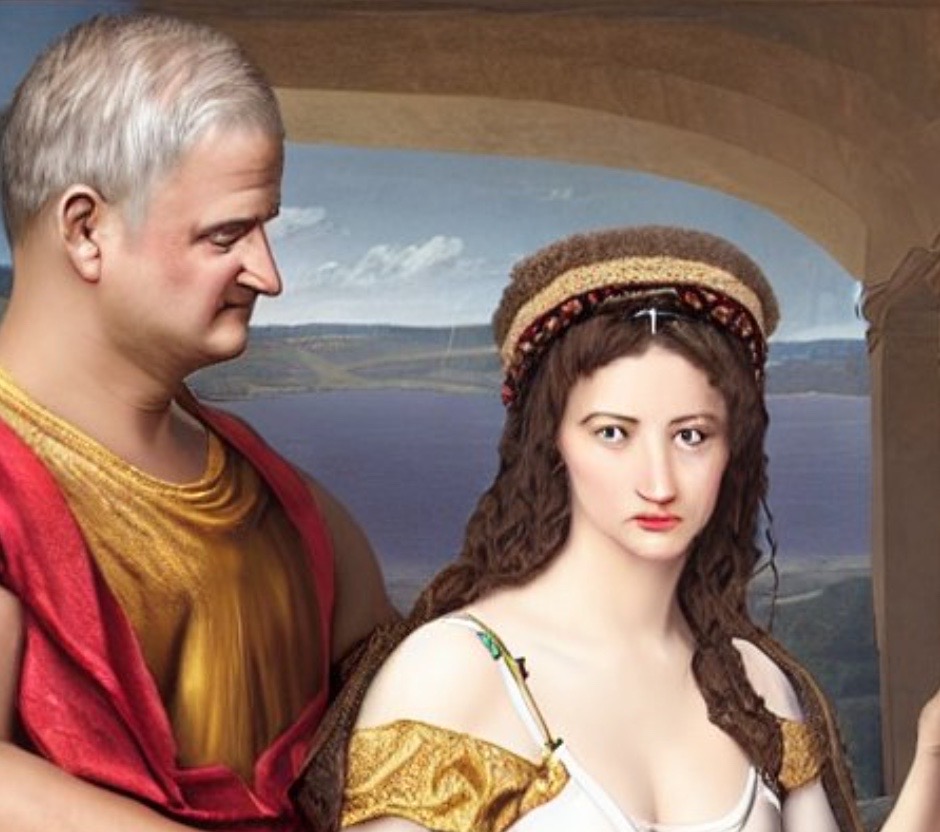
Vespasian would later marry Flavia Domitilla (“Domitiilla The Elder,”) who bore him three children but died before he became Emperor. After Flavia’s death, Vespasian resumed (or continued) his relationship with Caenis, now a freedwoman. She became his wife and Empress in all but name.
It is thought Caenis had family in Istria, but whatever the connection, she is credited with bringing prosperity to Pula.
Amphitheaters Worldwide
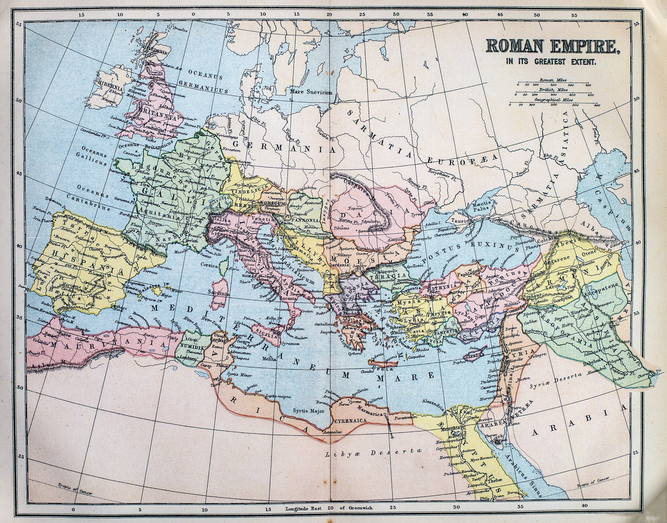
The Pula Arena is one of 230 amphitheaters discovered in the former Roman Empire, stretching from Western Europe to Northern Africa and parts of the Middle East.
Pula stands out for having four intact side towers and being the best-preserved of the three amphitheaters in Croatia. The other two are little more than ruins in Ivoševci, south of Zadar, and Solin, near Split.
A Harsh Life for Glory
Vespasian was a soldier who enjoyed gladiator battles. Gladiators were ranked by social status. The higher ranks comprised attractive slaves and freemen who fought for glory and money.
The lower ranks comprised criminals and prisoners of war who fought for their lives. They were fed barley porridge and expected to survive a few fights. Gladiator training was expensive, so the emperor wanted his money’s worth.
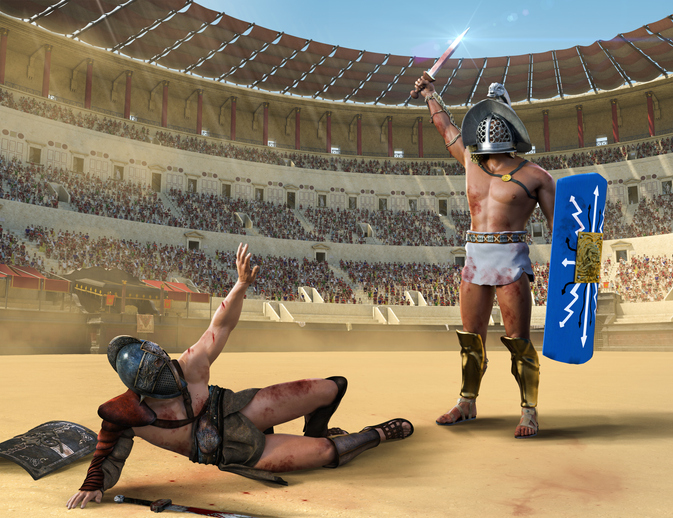
The Grim Reaper
As we sat in that empty arena, it came alive for me. Never mind that the gladiators in my head resembled Game of Thrones characters or my vague recollections of Charlton Heston in afternoon re-runs of Ben Hur.
I imagined how I would fake death if forced to fight for my life in the Pula Arena. Then, as if reading my mind, Martina put that notion to rest.
The fallen gladiators couldn’t pretend to be dead because—horror of horrors—someone was assigned to take a hammer to their heads to ensure they were dead.
Diversity Roman Style
It was no good consoling myself with the thought that these fights were always macho affairs because that was not the reality.
There were female gladiators too. They fought against other women and, in some cases, dwarfs. The latter scenario was one of the proclivities of Vespasian’s ruthless son, Emperor Domitian.

Lucky Women. Not!
To understand the allure of this ancient blood sport, imagine that the higher-ranked gladiators were today’s modern mega-star football players. They were revered, so much so that their sweat was scraped off into vials and given to the “lucky” women in the audience to use as perfume.
An Unfair Fight
The higher-ranked gladiators rarely died in the arena. To help ensure this, their opponents, the lower-ranked gladiators, were given shorter swords.
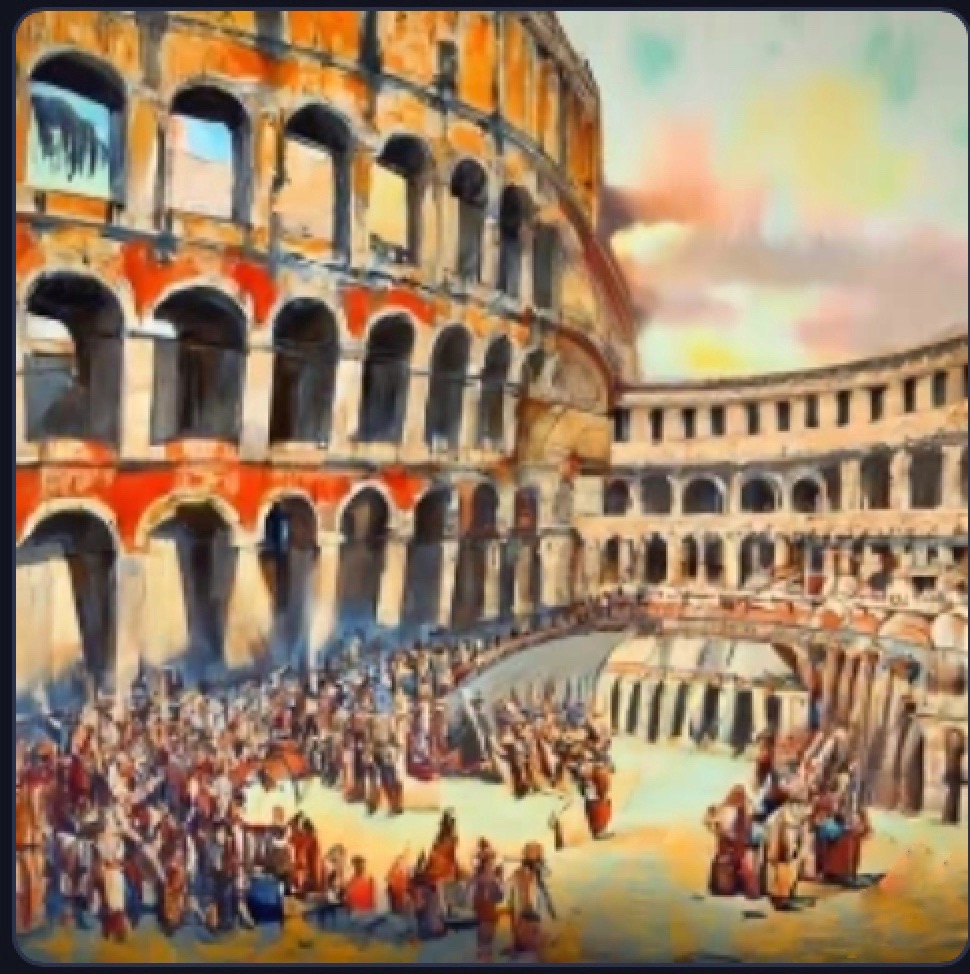
Even so, a gladiator’s fate was determined not by how well they fought but by the emperor and the spectators. When a gladiator fell injured to the ground, the referee stopped the game so the emperor could ask the crowd whether to spare their life or end it.
Hollywood movies often show the crowd making a thumbs-up or down gesture for mercy or death, but today no one knows the exact motion.
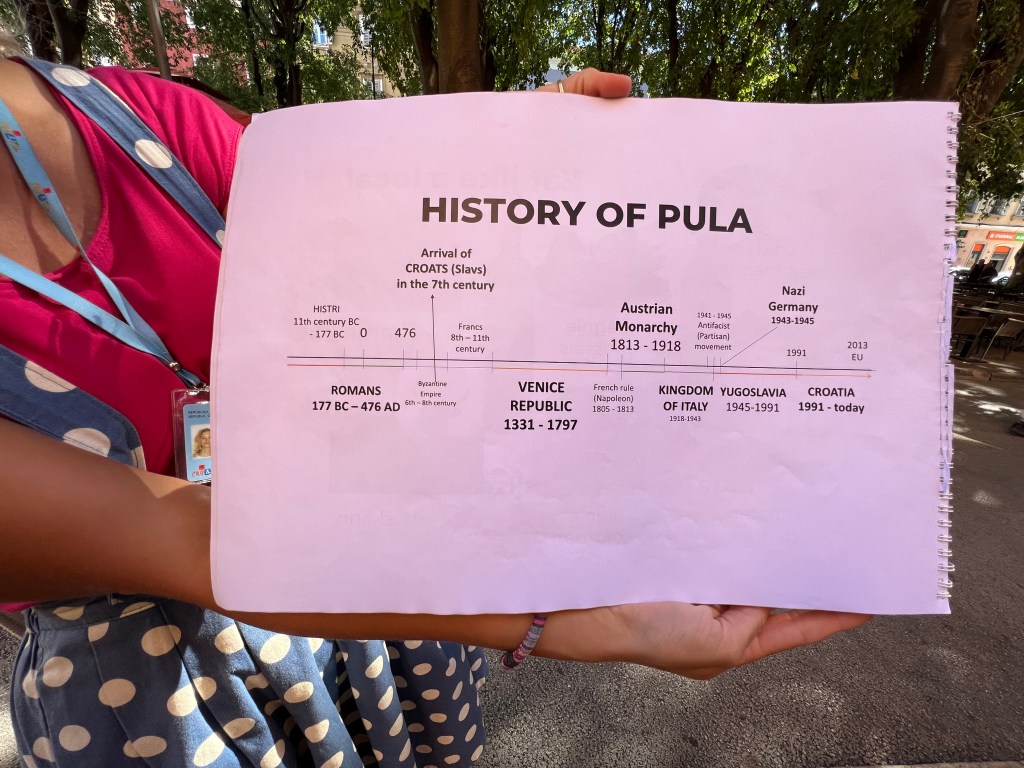
Spellbound, we looked on as Martina flipped through her large spiral-bound presentation booklet. Her timelines and photos led us through the annals of local history.
Why The Romans Colonized Pula
The Romans had grown tired of the fierce Histri pirates plundering their ships. It took several military campaigns before the Romans conquered Istria. When they did, they established Pola Herculanea (now Pula) as a colony and ruled for 700 years.
What Have The Romans Ever Done For Us?
By now, Martina was on a roll. As we all know, the ancient Romans are great fodder for comedy, Monty Python style.
“To quote a line from a Monte Python film, ‘What have the Romans ever done for us?” she asked. Before waiting for our reply to this comedic line from The Life of Brian, she launched into a monologue.
“Well, the Romans have done everything for us! Before they came, there were separate tribes that weren’t investing or building [infrastructure]. The Romans paved the roads and built public baths and a sewer system. They brought culture, education, and their multiple gods.”
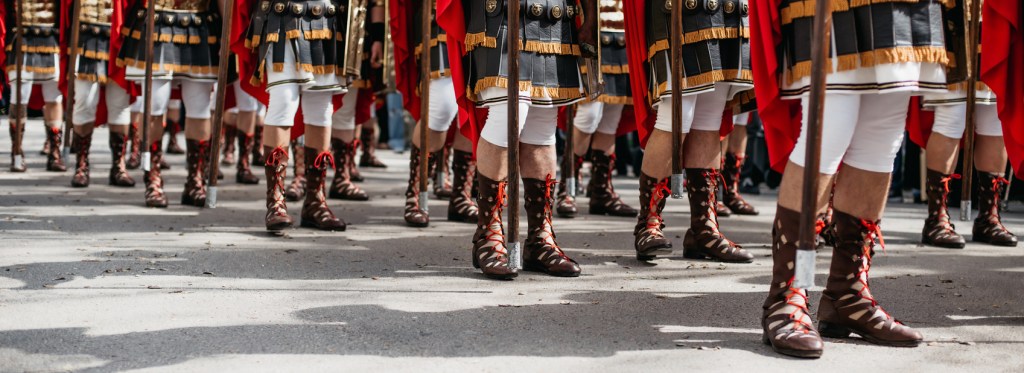
Martina noted that under Roman law, everyone in the Roman Empire had the same rights as citizens of Rome despite their different castes.”
Martina was a fan of Pula’s Roman legacy, but in my mind, the Romans had flaws. For one thing, they didn’t tolerate anything other than their multiple gods. As a result, Christians were tortured and killed in the Colosseum and amphitheaters throughout the Roman Empire. The patron saint of nearby Rovinj is a case in point. See Rovinj: A Romantic Getaway in Istria.
From Gladiators to Pop Stars
Today the Pula Arena seats 5,000 spectators who come for pop concerts, sporting events, and other performances.
Elton John, the Foo Fighters, Tame Impala, and the late Luciano Pavarotti have performed in the arena. Coming in June are Simply Red and Robbie Williams.
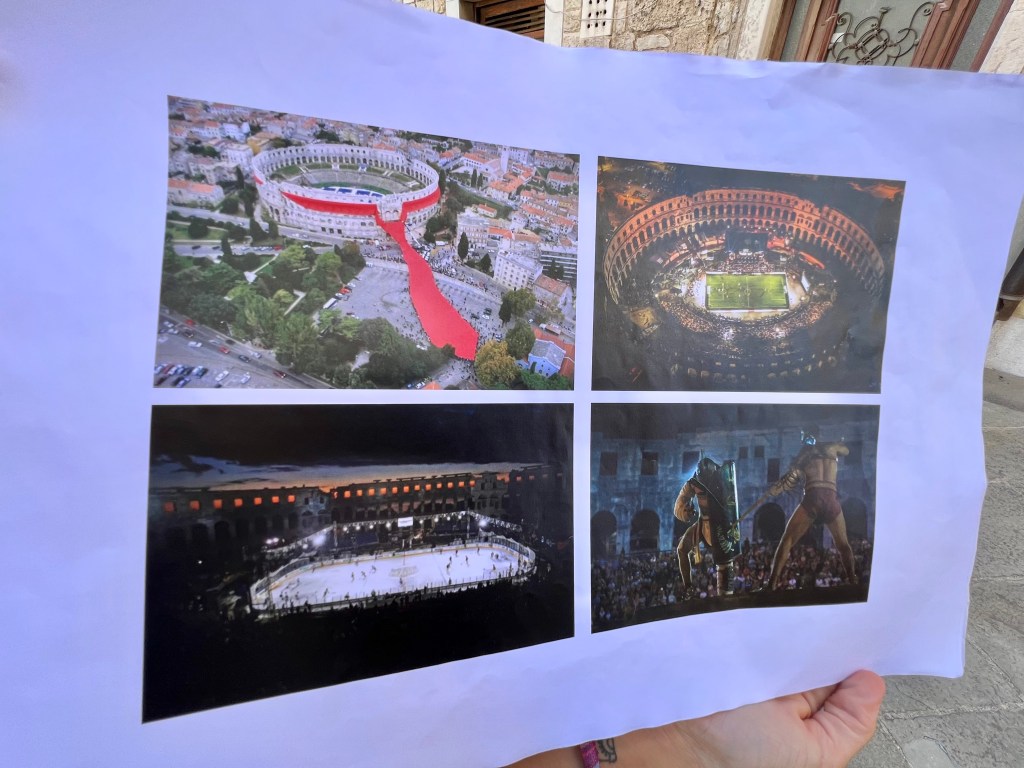
Sporting events from world heavyweight boxing and tennis matches are regularly held in the arena. There was even an ice hockey game between Slovenia and Croatia. Martina laughed as she recalled the ice melting under the warm Istrian sun.
One of the biggest crowd-pleasers is the annual mock gladiator battles from June to September. Those draw locals and tourists alike.
The Cravat: A Test of Fidelity
One of Martina’s photos showed a 2,650 ft red necktie draped around the Pula Arena in 2003. The Academia Cravatica was behind the stunt, and for its trouble Croatia won the Guinness World record for the longest necktie. Croatia claims it invented the cravat.
The CIA Factbook says the word “cravat” originated from the French name “Croate” for Croatia’s 17th-century mercenaries. It was altered to “cravate” and later referred to the soldiers’ short scarves.
There’s no question that Croatia is proud of its contribution to fashion. But folklore has passed down two stories about the military scarves.

One kinder, gentler version is that women tied a red cravat around their husband’s necks to symbolize love” as they went off to battle.
The other version is more cynical. Should the husband return from battle with a different knot, the wife would know he had cheated.
A Legacy of War and Peace
When writing about Pula, brevity is next to impossible. Pula was the crossroads for the ancient Romans and other civilizations and dynasties for several millennia.
During its turbulent 3,000-year history, Pula was sacked by the Octavian army in 44 BC, the Germanic Ostrogoths in the late 5th century AD, and the Venetians in the 14th century AD. After that, it was subjected to Napoleonic rule, then occupied by the Austro-Hungarians.

After World War I, Pula became part of the Kingdom of Italy. That rule led to Benito Mussolini’s oppressive Fascist government and ended abruptly after World War II.
Today Pula remains part of Croatia, which broke away from socialist Yugoslavia to become an independent country in 1991. A devastating civil war was sparked when ethnic Serbs living in the new Croatian state rebelled against the secession.
The Serb-controlled Yugoslav People’s Army (JNA) and local Serb forces fought bitterly against the Croats to retain statehood with Serbia. The war finally ended in 1995 with a Croat victory.
The Scars of History and Modernity
Perhaps the best way to get a taste of Pula is to send you on your way with my walking tour.
If you click on the Google map (below), you will see Roman arches, temples, and carved stone gates honoring Roman emperors and gods scattered in and around the Old Town.
Little remains of the Byzantine period after the Venetians sacked Pula. Only a chapel of the 6th Century Basilica of Saint Maria Formosa survived. The Temple of Augustus had been converted into a Byzantine church, but the British restored it to its former Roman glory after one of their bombs destroyed the temple in World War II.
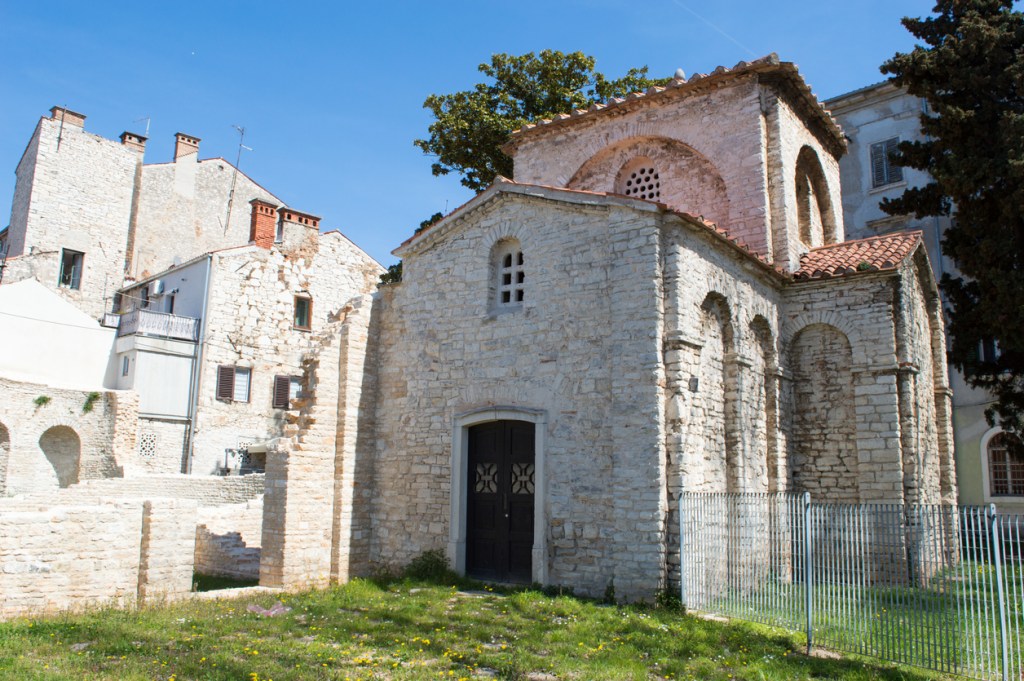
During the Dark Ages, stones from the old Roman walls and Pula Arena were carted away to build homes. Martina pointed out that the damage could have been far worse had the population not been decimated by plague and malaria.
Other monuments, such as the Temple of Augustus in the Forum (below), were victims of the 20th century. Much of Pula was destroyed by Anglo-American Air Force bombs during World War II.
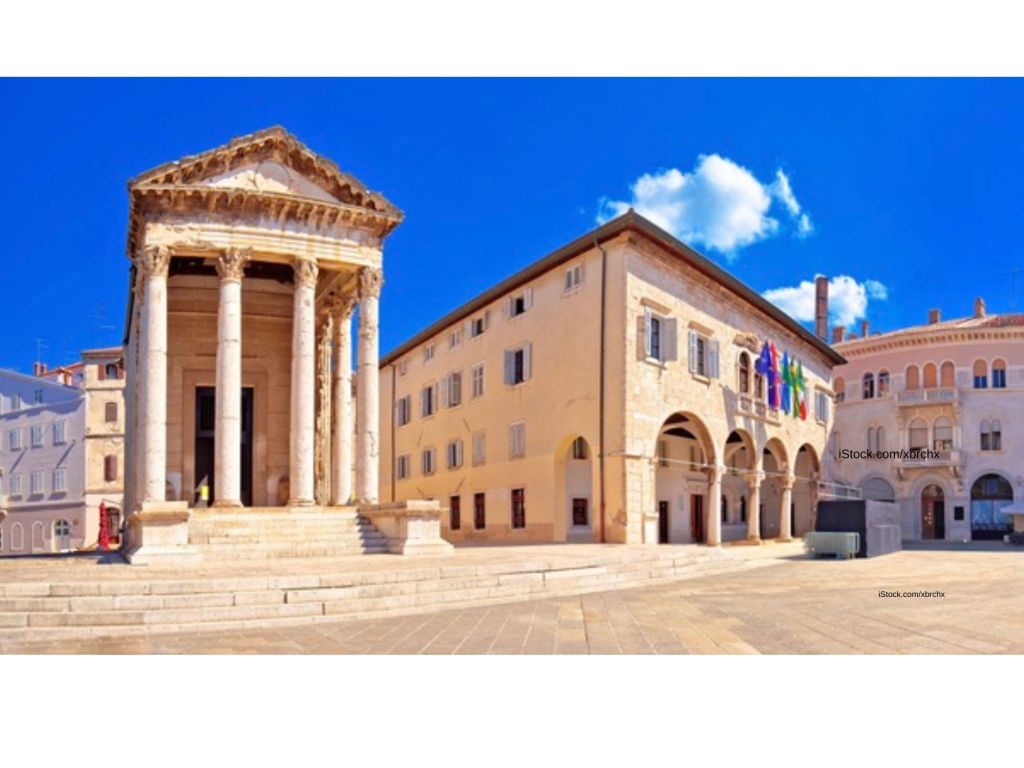
Most of these treasures have been restored, but Pula’s population growth has taken its toll too. Today only four of the 12 Roman gates remain. Some of these walls were simply in the way of progress.
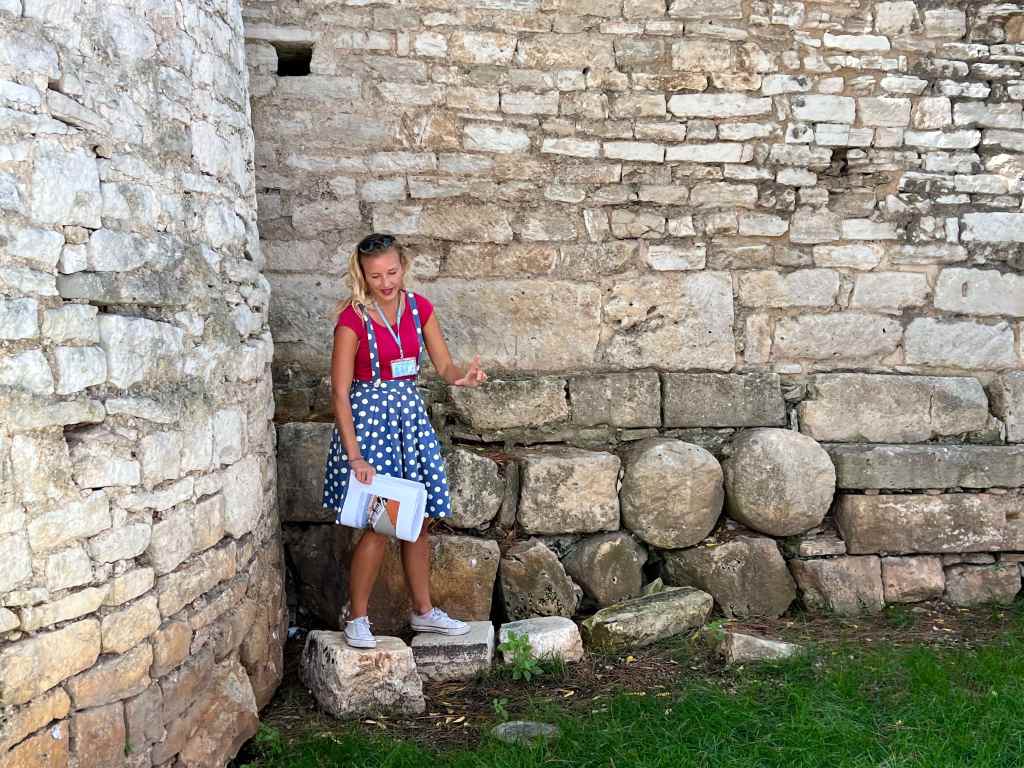
Today Pula is a patchwork of old and new influences. Ancient stone monuments stand next to pastel-colored Habsburg-era and Baroque buildings built during the Venetian Republic’s reign from 1331-1797.
Squat, faceless buildings from Pula’s socialist past are sandwiched between Roman monuments and Gothic churches are hidden behind warehouses. Many will consider these 20th Century structures modern blight, but I think they all have a place in history.
If you click on the map below and choose Google Earth (behind the three dots), you can walk through Pula’s streets today.
It is a fascinating journey through time, even without darling Martina.
Walking Tour of Pula
- Roman Antiquity
- Pula Arena - #1 On Map
- Arch of the Sergii “Triumphal Arch” - #9 On Map
- Forum - #14 On Map
- Roman Mozaic Floor “The Punishment of Dirka” - #12 On Map
- Roman Theater - #7 On Map
- Temple of Augustus in The Forum - #15 On Map
- Twin Gates “Porta Gemina”- #3 On Map
- Gate of Hercules “Herkulova Vrata” - #6 On Map
- Byzantine Dynasty
- Basilica of Saint Mary Formosa - #13 On Map
- Museums & Other Places of Interest
- Aura Distillery - #11 On Map
- The Archeological Museum - #5 On Map
- Pula Cathedral (Katedraia) Link to Pula Churches - #17 on Map
- Fortress Kaštel - #8 On Map
- The House of Istrian Olive Oil - #2 On Map
- Lighting Giants - #16 On Map
- Statue of James Joyce at Café Uliks - #10 On Map
- Zerostrasse Tunnels - #4 On Map
- Ratings are based on 1) Natural Beauty 2) Unique Activities 3) Old World Charm
This article is the 8th in my 19-part Balkan series, which began with ‘Road Tripping on the Balkan Peninsula’ in September 2023. There, you will find our itinerary to help you plan your trip.

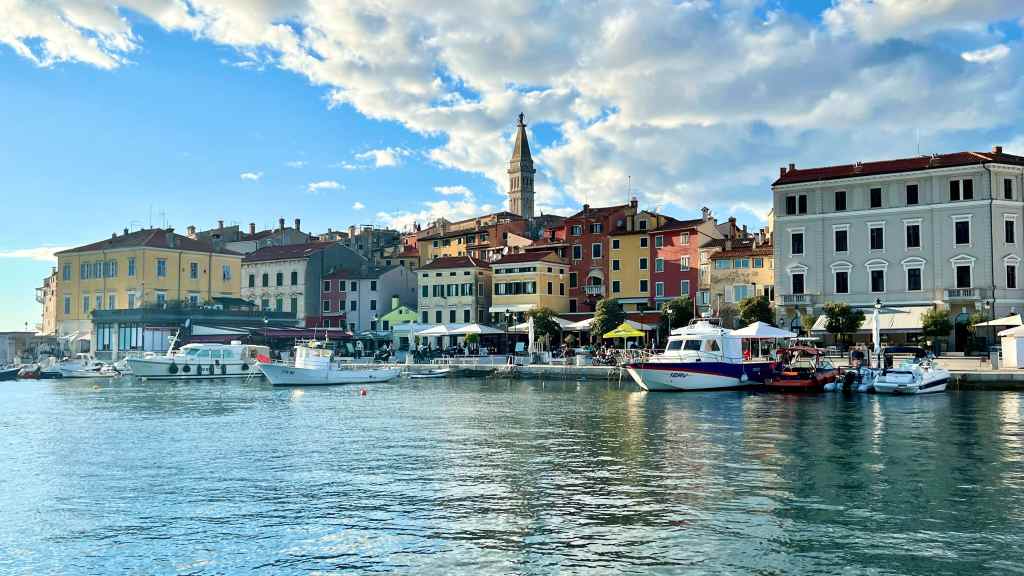











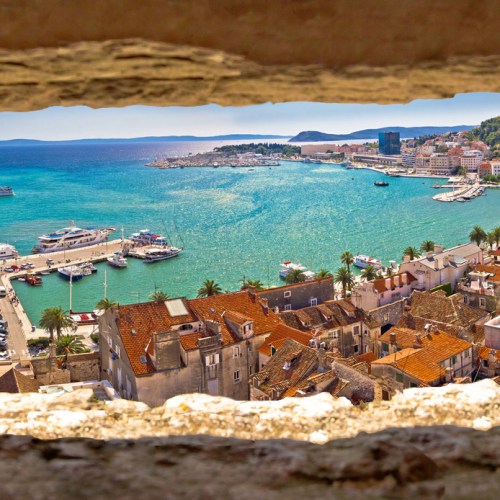
No comment yet, add your voice below!
Discover more from Travel The Four Corners
Subscribe now to keep reading and get access to the full archive.
Continue reading